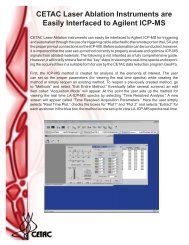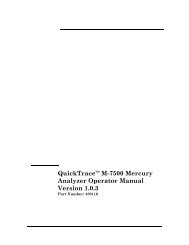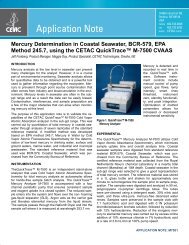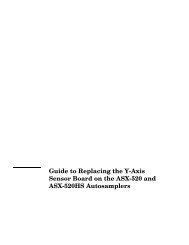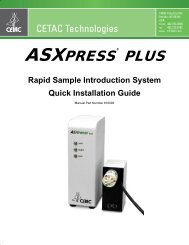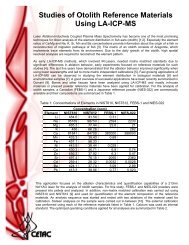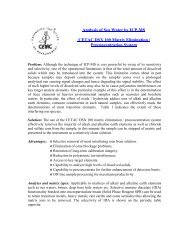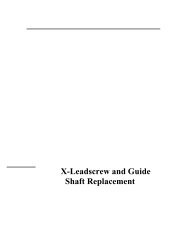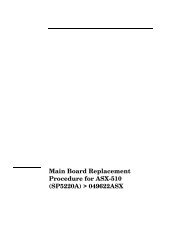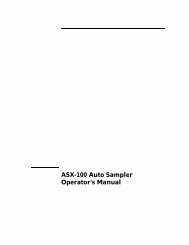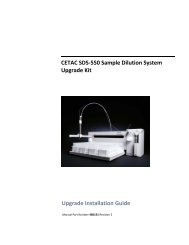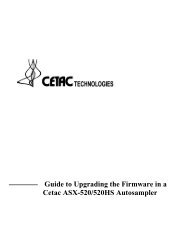CETAC M-7600 Mercury Analyzer Operator's Manual
CETAC M-7600 Mercury Analyzer Operator's Manual
CETAC M-7600 Mercury Analyzer Operator's Manual
You also want an ePaper? Increase the reach of your titles
YUMPU automatically turns print PDFs into web optimized ePapers that Google loves.
<strong>CETAC</strong> QuickTrace M-<strong>7600</strong> <strong>Mercury</strong> <strong>Analyzer</strong><br />
Chapter 5: Maintaining the <strong>Mercury</strong> <strong>Analyzer</strong><br />
Removing the Sample Cell<br />
Refer to Figure 5-3 and Figure 5-4. The cells are designed for simple removal<br />
and cleaning. When removing the cells, be careful to not touch the cell<br />
windows at the ends of the optical cells. If the cells and cell windows are dirty,<br />
use a clean foam swab and isopropyl alcohol (spectrophotometric grade only)<br />
to clean the surfaces (see page 107). If needed, the windows can be taken out<br />
by removing the end caps and the O-rings.<br />
Once the cell clamps have been removed, disconnect the carrier gas tubes from<br />
the cell end caps. Remove the cell end caps by holding the glass cell, pull, and<br />
rotate the end cap until it slides off the glass cell. Repeat this procedure for the<br />
reference cell. Inspect and/or clean the cell and its windows per the<br />
instructions beginning on page 107, or perform tubing maintenance as<br />
described in on page 113.<br />
Cleaning the Cell Windows<br />
Refer to Figure 5-4.<br />
There are two ways to clean cell windows:<br />
‣ Quick exposed surface cleaning (without dismantling).<br />
‣ Dismantling for total cleaning.<br />
The need for cleaning (or re-cleaning) is determined by close inspection of the<br />
window (D in Figure 5-4), visible through the hole in the window cap (A),<br />
while maintaining a low-angle total surface reflection of room light on the<br />
window. Any film, fingerprint, dust, or dirt will show up dramatically against<br />
the “white” background of a low-angle surface reflection of room light from the<br />
window.<br />
Quick Exposed Surface Cleaning<br />
Cleaning the exposed surface of the window requires the following: a clean<br />
foam swab, Kimwipes ® wipers, and a bottle of isopropyl alcohol (use only<br />
spectrophotometric grade).<br />
NOTE<br />
Do NOT use cotton swabs. They will leave small bits of lint, which can offset the<br />
absorbance baseline and add a great deal of noise, if the lint moves or flutters<br />
in the optical beam. Use only clean foam swabs. To pre-clean the foam swab,<br />
rinse in alcohol and dry with a KIMTECH SCIENCE KIMWIPES® delicate task<br />
wiper. Do not dip the swab in the alcohol supply (when new, the swabs may be<br />
dirty and contaminate the alcohol supply). Instead, squirt alcohol onto the<br />
swab with a wash-bottle that is for alcohol only and dry with the Kimwipes®<br />
wiper. Rinse and only lightly blot the swab with Kimwipes® wipers when<br />
cleaning; this will leave the swab moist with alcohol, which will be enough to<br />
clean the cell windows.<br />
Using the pre-cleaned, alcohol-moistened swab, gently swab the outside of the<br />
cell window. Wipe with a Kimwipes ® wiper and blow-dry with UHP Argon or<br />
Nitrogen. The blow-drying will also remove any lint or dust that may have<br />
107



